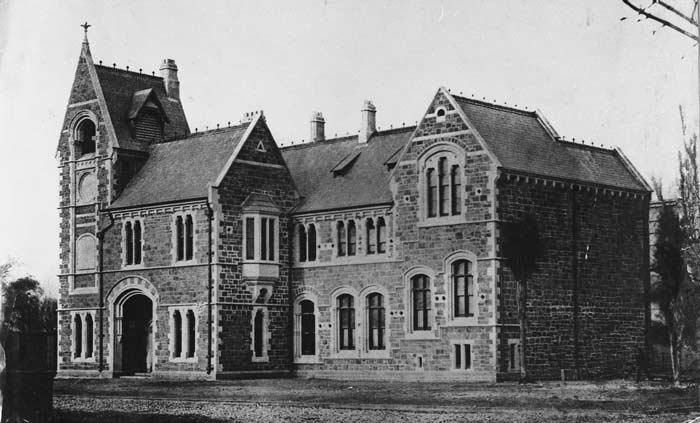In contrast to the temporary Tin Shed laboratory, the College’s first permanent addition was the Clock Tower, completed in 1877. The Board of Governors had set out to plan their first building in 1873, and a design by Benjamin Mountfort was accepted subject to some changes in 1874, but debate over where the building should be placed put the project on hold. Finally, the Board settled on the Worcester Street site as the permanent home of the College, and a smaller revised design by Mountfort was accepted, as the funding available no longer matched his original vision.

The Clock Tower

The Clock Tower, shown here before the East Wing or Great Hall were added, c.1877.
The Clock Tower cost the princely sum of £6,370, and was contracted out to be built by R.S. Seager. When complete it included the porters’ and registrars’ offices, the professors’ studies, a lecture room and a board room that featured a window incorporating the College Coat of Arms. Although not as impressive in scale as Mountfort’s design for the nearby Canterbury Museum, the Clock Tower in High Victorian Gothic was meant to evoke the traditions of the best English universities. To further emphasize the relationship of the new College to the likes of Oxford and Cambridge, the Colleges’ first Registrar Francis Stedman planted ivy that would eventually trail up the College buildings.
The opening of the College buildings coincided with the opening of the new Canterbury Museum building and a joint celebration was held. In attendance was the Governor Lord Normanby, and the College’s three foundation professors; John Macmillan Brown, Alexander Bickerton and Charles Cook. A.F. Douglas was a student of the College at the time, and recalled in his diary on 7th June that “The Canterbury College was opened in the morning at 12 by the Governor (Normanby) and in the evening there was a conversazione. 5/- a ticket – matriculated students free. About 800 present. Grand display. All held in the new room of the Museum, Christchurch.” The event obviously took its toll on some of the merry makers, as the entry for the following day notes “I found W. Taylor, schoolmaster L. Heathcote drunk at the Railway Station in ball dress. His face was black and his clothes covered with mud and his breeches coming down..."
It was immediately apparent that the Clock Tower would not provide enough space for the growing College. An extension was planned in 1876, designed again by Benjamin Mountfort, and building began in 1878. Completed by 1879, the East Wing extension allowed for five more rooms, including classrooms for modern languages, biology and geology. The extension also saw the introduction of the first carved stone Coat of Arms to the College buildings, and the installation of the College Clock. As with all the College’s buildings, the use of the spaces changed over the years as teaching demands evolved. By the 1960s the Clock Tower was home to the Macmillan Brown Library, which seems fitting given that Macmillan Brown himself held sway there in the first years of the College’s existence. More recently the Tower may be remembered as home to the Arts Centre’s Visitors Centre, and Le Café.